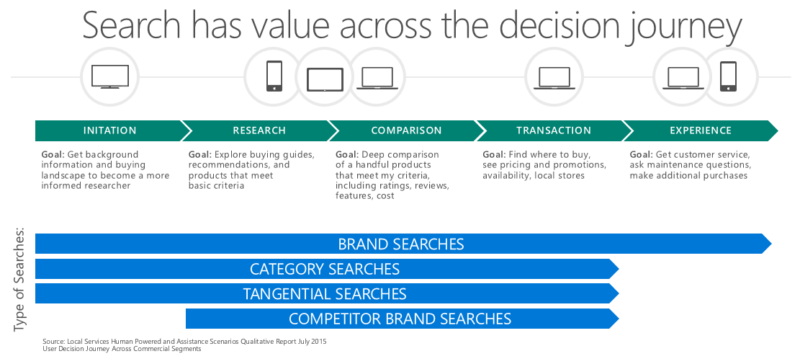The value of search across the modern consumer decision journey
Columnist Christi Olson of Bing shares research on how search fits into the overall buyer's journey, reaching consumers at all stages in the funnel.
As disruptive technologies reshape the digital marketing landscape, advertisers are scrambling to stay relevant and top of mind with consumers. In this shifting landscape, paid search continues to evolve outside of the traditional search format as an omnipresent influencer throughout the entire consumer decision journey.
For years, search marketers have obsessed over bottom-of-the-funnel activity for its seemingly higher CTRs and conversion rates, in part fueled by last-click attribution. I’ve certainly been guilty of obsessing about conversions and bottom-of-the-funnel tactics, because they would win me incremental search budget in the future.
But most marketers today agree that it is essential for a brand to appear at all stages of the funnel — and thanks to some new findings from the Bing Ads research team, we now have even more visibility and hard data to show how paid search is driving brand affinity and recall across the decision journey.
Deconstructing modern decision journeys & query paths
In many ways, today’s search marketers must unlearn some old practices and adopt a new mindset, delving deeper into individual customer journeys and query paths. Paid search is no longer a product with broad KPIs, such as conversions and clicks. Clicks are no longer clicks; they represent individual consumers on specific journeys.
Search today gives us intelligence through each stage of the decision journey, not just bottom-of-funnel conversions. To begin, let’s dissect the modern decision journey and query path.
There are five distinct stages within a consumer’s decision journey: initiation, research, comparison, transaction and experience. For different types of journeys, each stage has a different level of importance that depends on cost of failure, frequency of purchase, cost and complexity of the task and the type of shopper.
Each journey is highly personalized and will vary in length and importance. Whether a consumer is hopping online to replace a broken baby bouncy chair or researching a new hot water heater after taking yet another freezing cold shower, marketers must reach the right person at the right moment with the right message.
According to a recent research study by Forrester, 71 percent of consumers begin their journeys by using a search engine to discover new products and services (initiation), and 74 percent reported using a search engine for consideration and purchasing (research, comparison, transaction).
These searches span many different types of queries:
- Brand searches include a specific brand or product name. For example, Fischer-Price is the brand, and product searches could include Little People or Power Wheels.
- Competitor brand searches include your competitors’ brands or products. This is an opportunity for your brand to appear through conquest advertising. For Fischer-Price, these terms could include Exersaucer, Baby Einstein or Safety First.
- Category searches include broad search terms that are not product- or brand-specific, such as “baby activity center,” “bouncer chair” or “jumpers.”
- Tangential searches include searches that are related to a given journey, but not in exactly the same category. For instance, if I’m searching for baby activity chairs, a tangential search could be for “baby gates” or “childproofing products.”
Research findings: Non-brand searches are key to starting a journey
While traditional search has always placed a premium on brand keywords, the Bing Ads research team has uncovered new insights on the role of non-brand search terms within today’s journeys.
Utsav Biswas, Jacquelyn Krones and Judson Randolph of the Bing Ads research team conducted a Brand Impact Study on usage data from a major US auto retailer and determined that 72 percent of brand ad clicks (which includes category, competitor and tangential searches) had a non-brand keyword that preceded the brand click. This indicates that retailers who do not run non-brand keywords throughout multiple stages of decision journeys are missing out on a high majority of relevant searches and are leaving wide open spaces for their competitors.
Additionally, the research showed that consumers who are exposed to a brand ad on a category or competitor query were 30 percent more likely to do a branded search and on average had a 15 percent higher conversion rate than consumers who were not exposed to the brand ad. Having a branded ad appear in category and competitor brand queries improved brand affinity and recall and increased the propensity for future brand searches.
Research findings: Incremental awareness and perception value
The Bing Ads research team also completed a study in Q3 2016 with a leader in the automotive insurance vertical to measure brand awareness and perception based on exposure to ads within the search results pages. The key learning from this study was that searchers on Bing who saw a branded ad for non-branded search queries showed a statistically significant increase in brand awareness, perception and purchase intent.
After being exposed to a branded ad, searchers indicated a 24 percent lift in unaided awareness, a 28 percent lift in purchase intent and a 30 percent lift in viewing the retailer as a market leader. Brand awareness further improved when searchers clicked through on the ad and were taken to the brand’s landing page.
Although search marketers have long assumed some level of brand awareness in search, it is the amount of brand awareness shown here that proves impressive and indicates the importance of staying present throughout each stage of a journey.
Search continues to dominate conversion activity
As search continues to evolve and play integrated roles farther up the funnel, it still dominates within bottom-of-funnel conversion activity. According to a Forrester Consumer Technographics survey from Q1 2016, 49 percent of consumers reported that they rely on search to inform purchase decisions, and 19 percent of respondents identified search engines as the most influential source in driving their purchase decisions. In partnership with Pepperjam and Bing Ads, an attribution analysis study found that 58 percent of the time search is the final or only event within a purchase path, showing the value that search brings at the end of the decision journey.
Last month, I noted how desktop search is still converting at a higher rate than mobile search, with 80 percent of US retail e-commerce sales occurring on a desktop device. Similarly, Marin Software’s Q4 2016 Performance Marketer Benchmark Report shows the ability of search to convert visitors, especially when compared to social and display campaigns.
Of course, this doesn’t mean to only advertise on search. A 2015 case study found that paid search conversion rates increased up to 52 percent when search and display ads were running simultaneously. Similarly, Marin Software’s multiplier effect report showed that consumers who clicked on search and social ads were 2x more likely to convert and spend more.
Now is a great time to approach paid search with a fresh view, looking at the value of reaching the consumer across the entire journey. A view that replaces clicks with individual consumers, that replaces linear query paths with holistic brand experiences and ultimately replaces a single conversion with lifetime value and brand loyalty.
Opinions expressed in this article are those of the guest author and not necessarily Search Engine Land. Staff authors are listed here.
Related stories



